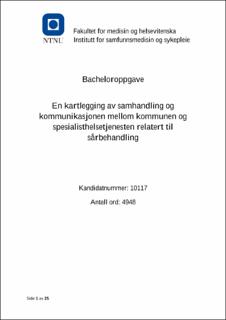| dc.contributor.advisor | Aune, Anne Grethe | |
| dc.contributor.author | Lauritzsen, Knut | |
| dc.date.accessioned | 2020-07-17T16:02:16Z | |
| dc.date.available | 2020-07-17T16:02:16Z | |
| dc.date.issued | 2020 | |
| dc.identifier.uri | https://hdl.handle.net/11250/2669533 | |
| dc.description.abstract | Sammendrag
Hensikten med denne studien er å kartlegge kommunikasjonen og samhandlingen mellom spesialist og kommunehelsetjenesten, relatert til kroniske leggsår.
Studiens problemstilling er: «Gir samhandlingen og kommunikasjonen mellom spesialist- og kommunehelsetjenesten et helhetlig tilbud for pasientene, i forhold til oppfølging av kroniske leggsår?»
Dette er en kvalitativ studie der det er benyttet semistrukturerte intervjuer. Det ble utført intervjuer med sykepleiere fra ulike soner hjemmetjenesten og sykehuset i samme kommune. Det ble gjort en meningsanalyse av datamaterialet fra intervjuene. Data fra intervjuene ble analysert og brukt etter metoden fra Kvale og Brinkmann (2015).
Pasienter med kroniske leggsår blir i dag behandlet både av kommunal og spesialisthelsetjenesten. Forskning viser at disse pasientene ikke alltid får den helhetlige oppfølgingen de trenger for at såret deres skal leges (15). Dette er uheldig da det koster samfunnet mye penger i sårutstyr og medfører ekstra arbeid for helsevesenet (9, 18). I tillegg kommer det menneskelige lidelser når sår til denne pasientgruppen ikke blir bedre (3, 4, 15). Universitetssykehuset ønsket å finne ut av årsakene til at samhandlingen og kommunikasjonen med kommunen ikke er optimal.
Noen av informantene mente at samarbeidet gikk bra, mens majoriteten hevdet at det var problematisk og rom for forbedring på flere områder.
Hovedproblemstillingene som ble avdekket i studien var ulike leverandører på sårutstyr, mangel på metoder for enkel og direkte kommunikasjon, sårprosedyrer som er vanskelig å skjønne selv for fagpersonell, mangel på kontinuitet og begrensede ressurser samt krevende arbeidsforhold for hjemmetjenesten. Dette fører til at flere pasienter med kroniske leggsår ikke får et helhetlig tilbud.
Det er gjennom tiltak som utveksling av telefonnummer for enklere kommunikasjon, mer internundervisning for hjemmetjenesten angående sår, begrense ansvaret for behandlingen på færre pleiere og oppslagsverk for samsvar i sårutstyr at samarbeidet mellom spesialist- og kommunehelsetjenesten kan bli mer vellykket. | |
| dc.description.abstract | Abstract
The aim of this study was mapping the communication and interaction between the health specialists and the municipality, regarding chronic leg ulcers.
The study’s main topic is: “Does the interaction and communication between the specialist- and municipal health services give a comprehensive offer to the patients, regarding the follow-up of venous and mixture-ulcers?”
This is a qualitative study utilizing semi-structured interviews. Nurses from the homecare of three different zones in the municipality, and the hospital were interviewed. It was done an opinion-analysis of the data from the interviews. The data from the interviews was analysed and used with the method from Kvale and Brinkmann (2015).
Most patients with chronic leg ulcers alternate between both municipal and specialist health services in Norway. Research shows that these patients does not always get the comprehensive follow-up needed for their wound to heal (15). This is unfortunate due to the high cost of wound equipment and causing extra workhours for the healthcare services, when these wounds do not heal (9, 18). In addition to human suffering when this group of patients does not get well (3, 4, 15). The hospital wished to figure out the reasons of why the interaction and communication with the municipal were not favourable.
While some of the informants meant that the cooperation went well, the majority claimed that it was problematic and room for improvement in several areas.
The main issues revealed in the study were different suppliers of wound equipment, a lack of methods for easy and direct communication, wound-procedures that are hard for even professionals to understand and the limited resources of the home care. This causes numerous patients with chronic leg ulcers to not get sufficient care, since the follow-up they need for the wound to heal is not sufficient.
It is through measures like the exchange of phone numbers for easier communication, more tutoring about wound treatment for the home care, limit the responsibility for the treatment to a few nurses and an encyclopaedia for equivalent equipment that the cooperation between the specialist and municipal healthcare services can start to improve. | |
| dc.publisher | NTNU | |
| dc.title | En kartlegging av samhandling og kommunikasjonen mellom kommunen og spesialisthelsetjenesten relatert til sårbehandling | |
| dc.type | Bachelor thesis | |
